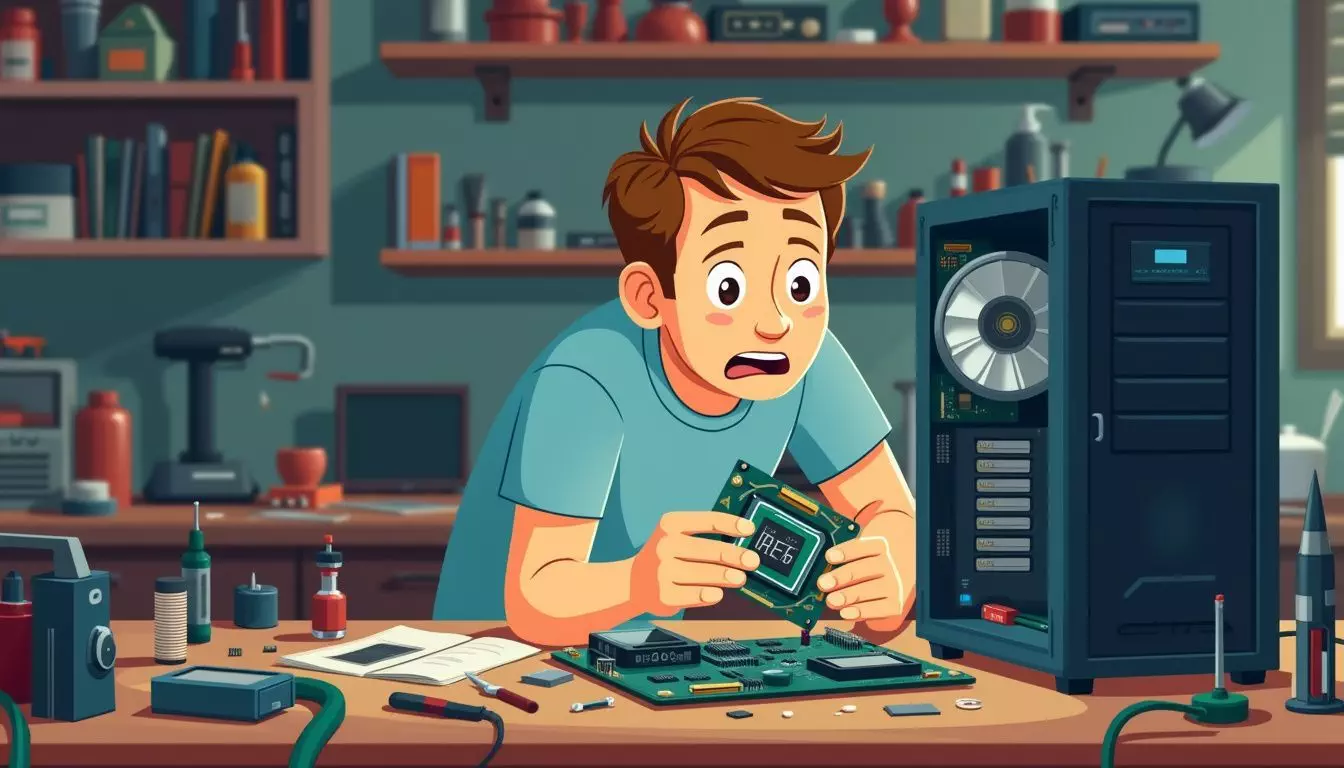Did you know that using bad thermal paste can spell disaster for your CPU? It’s a serious problem most people overlook, but knowing exactly “what does bad thermal paste look like” can save you headaches.
This guide will show you how to spot expired or faulty paste before it causes performance issues or damages your hardware. 1
Alex Herrick, with his deep expertise in web design and research, brings invaluable tips to tech enthusiasts. His detailed approach ensures you’ll have practical advice on keeping your CPU cool with good thermal practices.
Keep reading to catch all the essential points! 3
Key Takeaways
- Watery, Hard, or Flaky Paste
Bad thermal paste can look watery, hard like clay, or flaky. Good paste should be thick and smooth. - Overheating and Inconsistent Temps
Overheating and jumping temperatures are signs of bad thermal paste. Watch for high fan speeds too.
- Frequent Shutdowns and Throttling
Your computer may shut down often to cool off if the paste is bad. It might also slow down when hot.
- Potential Hardware Damage
High CPU temps over 99°C can cause damage. Metal-based pastes can leak and short-circuit parts.
- Regular Checks Needed
Check your thermal paste every 3-4 years or if you notice overheating issues to avoid problems.
Identifying Bad Thermal Paste

Bad thermal paste often looks different. It can make your CPU overheat or show uneven temps….
Visual Indicators: Watery, Hard, or Flaky Textures
Bad thermal paste can seriously affect your CPU cooling. Here’s how to spot it:
- Watery Consistency
If the thermal paste is watery, it’s gone bad. Good paste should be thick and smooth. Watery paste can’t transfer heat well. 1
- Hard Texture
When thermal paste dries out, it becomes hard like clay. This can cause gaps between the CPU and heatsink, leading to poor cooling.
- Flaky Appearance
Old thermal paste often looks flaky or crusty. Flakes can’t stick properly to the surfaces, reducing heat transfer efficiency.
Identifying these signs helps in deciding when to replace thermal paste for better CPU performance. Check every 3-4 years or if you notice overheating issues to keep your system in top shape. 2Performance Symptoms: Overheating and Inconsistent CPU Temperatures
A computer with bad thermal paste can show problems fast. Watch out for these performance symptoms:
- Overheating: The CPU might get too hot. Safe temperatures are below 60-65°C when idle and under 80-85°C at full load. 3
- Inconsistent Temperatures: The CPU temperature can jump up and down. Stable temperatures mean good thermal paste.
- Frequent Shutdowns: Overheating can make the computer shut down by itself to protect the hardware. 4
- Throttling: The CPU might slow down to keep cool. This affects performance, especially during gaming or heavy tasks.
- High Fan Speeds: If fans run loud and fast more often, it suggests poor cooling efficiency.
CPU health depends on good cooling practices, including replacing bad thermal paste regularly.
Consequences of Using Bad Thermal Paste
Bad thermal paste can cause your CPU to overheat. This may lead to throttling and slow performance.
Reduced Cooling Efficiency
Using bad thermal paste lowers cooling efficiency. Air bubbles in bad paste block heat transfer. This means your CPU and GPU run hotter. 2
Thermal grease must be spread evenly. Too much or too little causes problems. Your computer’s performance will drop, and parts might overheat. 1Potential Hardware Damage
Bad thermal paste can hurt your CPU and GPU. High CPU temperatures, like 99°C, cause thermal throttling. 5 This slows down your computer. High GPU temperatures, between 80-90°C, damage the graphics card.
Metal-based pastes may leak and short circuit other parts. Insulative pastes might stick to components. This causes them to malfunction. 1
High temps mean trouble for CPUs and GPUs.
Conclusion
Expired thermal paste hurts CPU cooling. It looks watery, hard, or flaky. These signs affect performance and can damage hardware. Replace bad paste to improve cooling efficiency and protect your system.
Invest in quality thermal paste for long-lasting results.
For more information on maintaining your computer’s health, check out our detailed guide on what is computer imaging.
FAQs
1. How can I tell if my thermal paste has gone bad?
Bad thermal paste often looks dry, cracked, or crumbly. If it doesn’t spread easily when applying to your CPU’s surface, it’s likely expired and needs replacing.
2. What happens if I apply too much thermal paste?
Applying too much thermal paste can cause it to spill over the edges of the CPU, leading to poor heat transfer and potential damage to other components like the motherboard.
3. How do I know when to replace my CPU’s thermal paste?
You need to replace the thermal paste if you notice higher-than-usual temperatures on your processor or GPU during normal operation—this could indicate that the old paste is no longer effective.
4. Can dust affect how well my computer cooling works with new thermal compound?
Yes, dust can block airflow around your cooler and heatsink, reducing their efficiency even with fresh thermal gel applied.
5. Is there a step-by-step guide for applying new thermal compound?
Yes! First, remove the heatsink from your CPU… clean off old residue… apply an even amount of new compound using a syringe… then reattach everything securely.
6. Does unopened thermal grease expire over time?
Unopened tubes of grease (lubricant) have a shelf life but will eventually expire—check for changes in texture before use on any machine or desktop PC system.
References
- ^ https://koolingmonster.com/insights/what-should-good-and-bad-thermal-paste-look-like-on-cpu (2024-05-26)
- ^ https://www.powerelectronicsnews.com/a-comprehensive-guide-to-thermal-paste-and-its-benefits-in-modern-electronics/
- ^ https://www.linkedin.com/advice/0/what-common-mistakes-risks-applying
- ^ http://www.jawa.gg/blog/how-to-check-cpu-cooler/
- ^ https://forums.tomshardware.com/threads/bad-thermal-paste-or-bad-cooling.3650308/

